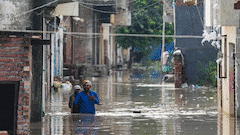North India Feels Massive Jolt As 6.6 Magnitude Earthquake Strikes Afghanistan
Earthquake in Delhi: Strong Earthquake tremors were felt in Delhi-NCR on Tuesday, reported news agency ANI.

Strong Earthquake tremors were felt in New Delhi, Punjab and other parts of North India on Tuesday around 10:17 pm with its epicentre 90 km from Kalafgan in Afghanistan. The 6.6-magnitude earthquake struck Turkmenistan, India, Kazakhstan, Pakistan, Tajikistan, Uzbekistan, China, Afghanistan, and Kyrgyzstan, according to reports. The tremors, which lasted for nearly a minute, were felt across northern India in states like Uttarakhand, J&K, Delhi, and UP.
BREAKING | दिल्ली-NCR में भूकंप के झटकेhttps://t.co/smwhXUROiK#Delhi #DelhiNCR #Earthquake #Breaking pic.twitter.com/wJmuMIXC10
— ABP News (@ABPNews) March 21, 2023
The National Centre for Seismology reported that the earthquake occurred in Afghanistan 133 kilometers southeast of Fayzabad.
Afghanistan is habitually hit by tremors, particularly in the Hindu Kush mountain range, which lies close to the intersection of the Eurasian and Indian structural plates.
A Noida resident said he first noticed the dining table shaking. "Soon after we saw that the fans were also shaking. The earthquake was strong in terms of intensity and stayed for a longer period," the resident of Hyde Park society in Noida was quoted saying by the agency.
VIDEO | People rush out of their houses in Delhi-NCR as earthquake felt in north India. pic.twitter.com/qfxYolZhy2
— Press Trust of India (@PTI_News) March 21, 2023
#delhiearthquake
— Abhishek Chakraborty (@deshbhaktbong) March 21, 2023
Residents make their way to the assembly area in Noida's #SupertechCapeTown pic.twitter.com/svkaRXTzXt
Meanwhile, Fire Director Atul Garg said, "No building in Shakarpur area was found tilted. An initial call was given by some of the neighbours. The occupants of the building were not aware of the call."
Mahesh Palawat, Vice president Meteorology And climate tweeted, “It wa a strong #earthquake. Worse is over now. Aftershocks are usually milder. Of moderate intensity. Can damage old buildings in the vicinity which are damaged by main event. May not be felt in #India. no worries. #AfghanistanEarthquake #earthquake"
#Epicenter of #earthquake was far away in #Afghanistan. No need of panik. No damage is expected in India. Tremors are more strong in northern states of J&K and north #Punjab. It is the joint of Indian and Eurasian #tectonic plates lies in zone 5. @SkymetWeather @JATINSKYMET
— Mahesh Palawat (@Mpalawat) March 21, 2023
An AFP correspondent in Rawalpindi reported that "people ran out of their houses and were reciting the Koran." Similar reports were also received from Pakistan's capital Islamabad, Lahore, and other cities.
In excess of 1,000 individuals were killed and several thousands made destitute after a 5.9-magnitude quake - - the deadliest in Afghanistan in almost a fourth of a long time - - struck the ruined region of Paktika on June 22 last year.
Earthquake zones of India
India is divided into four seismic zones based on the intensity of earthquakes that are likely to occur in these areas.
Zone V is the most severe intensity zone, which includes parts of Jammu and Kashmir (Kashmir valley), the western part of Himachal Pradesh, the eastern part of Uttarakhand, Kutch in Gujarat, part of northern Bihar, all northeastern states of India, and the Andaman & Nicobar Islands.
Zone IV is the severe intensity zone and includes Ladakh, remaining parts of Jammu & Kashmir, Himachal Pradesh and Uttarakhand, some parts of Haryana, parts of Punjab, Delhi, Sikkim, the northern part of Uttar Pradesh, small portions of Bihar and West Bengal, parts of Gujarat and small portions of Maharashtra near the west coast, and a small part of western Rajasthan.
Zone III is the moderate intensity zone, which includes Kerala, Goa, Lakshadweep islands, parts of Uttar Pradesh and Haryana, remaining parts of Gujarat and Punjab, parts of West Bengal, western Rajasthan, Madhya Pradesh, remaining part of Bihar, northern parts of Jharkhand and Chhattisgarh, and parts of Maharashtra, Odisha, Andhra Pradesh, Telangana, Tamil Nadu and Karnataka.
Zone II is the low intensity zone, which includes remaining parts of Rajasthan, Uttar Pradesh, Gujarat, Haryana, Madhya Pradesh, Maharashtra, Odisha, Andhra Pradesh, Telangana, Karnataka, and Tamil Nadu.
Related Video
Delhi News: Toxic Air Engulfs Capital as CM Rekha Gupta Alters Office Timings Amid Pollution
Top Headlines





































